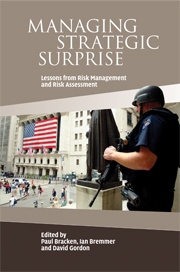Book contents
- Frontmatter
- Contents
- List of figures
- List of tables
- List of contributors
- Acknowledgements
- 1 Introduction
- 2 How to build a warning system
- 3 Intelligence management as risk management: the case of surprise attack
- 4 Nuclear proliferation epidemiology: uncertainty, surprise, and risk management
- 5 Precaution against terrorism
- 6 Defense planning and risk management in the presence of deep uncertainty
- 7 Managing energy security risks in a changing world
- 8 What markets miss: political stability frameworks and country risk
- 9 The risk of failed-state contagion
- 10 Conclusion: managing strategic surprise
- Index
- References
8 - What markets miss: political stability frameworks and country risk
Published online by Cambridge University Press: 14 May 2010
- Frontmatter
- Contents
- List of figures
- List of tables
- List of contributors
- Acknowledgements
- 1 Introduction
- 2 How to build a warning system
- 3 Intelligence management as risk management: the case of surprise attack
- 4 Nuclear proliferation epidemiology: uncertainty, surprise, and risk management
- 5 Precaution against terrorism
- 6 Defense planning and risk management in the presence of deep uncertainty
- 7 Managing energy security risks in a changing world
- 8 What markets miss: political stability frameworks and country risk
- 9 The risk of failed-state contagion
- 10 Conclusion: managing strategic surprise
- Index
- References
Summary
Investors in emerging markets have long been aware that political instability and volatility can have profound commercial implications. As a consequence they have developed various tools to evaluate risk in these environments. But in spite of the high commercial stakes, the track record of anticipating and managing these types of problems is decidedly mixed. As the relevance of political factors has become more apparent to investors, so has the general lack of comprehensive and systematic tools for evaluating them.
This essay outlines the basic metrics for evaluating “sovereign” or “country” risk in emerging markets. It then outlines a “state stability index” framework that captures social and political factors that often are not picked up in traditional commercial models and approaches. This framework is also relevant for issues of national security, as it provides both a country-specific and broadly comparative framework to identifying key risk indicators. Beyond an introduction to the framework, this paper includes applied case studies on Russia, Brazil, and Hungary.
Standard approaches
Traditional sovereign credit risk analysis focuses principally on assessing a country's ability to meet its debt obligations. Sovereign risk ratings typically incorporate the following explanatory factors:
Per capita income
GDP growth
Inflation
Fiscal balance
External balance
External debt
Economic development
Default history
Credit analysts in ratings agencies and banks also typically include “politics” as an additional explanatory factor. But they quickly add that it is very difficult to operationalize, and as a consequence it is often tacked on as an “error” term.
- Type
- Chapter
- Information
- Managing Strategic SurpriseLessons from Risk Management and Risk Assessment, pp. 265 - 286Publisher: Cambridge University PressPrint publication year: 2008



